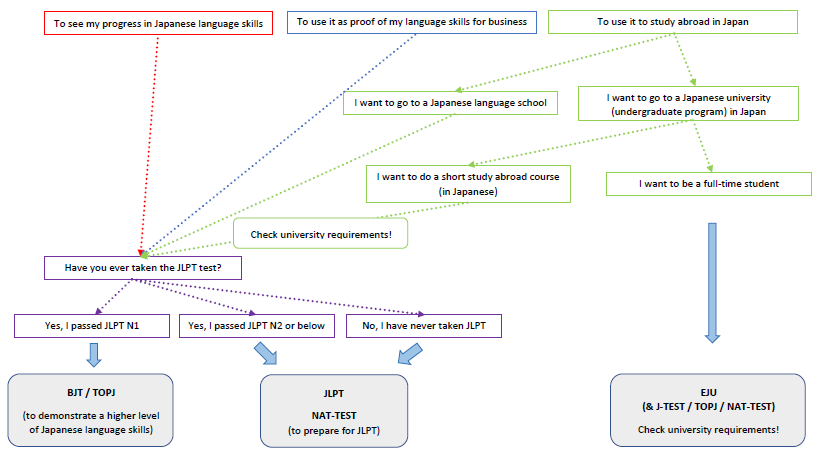Overview of Japanese Language Tests
If you are thinking of studying, working, or obtaining a visa in Japan, having a good score in one or more Japanese language tests will increase your chances and opportunities to be accepted into the higher education program, or support your resume for the employment opportunities that you seek. This article provides information on all of the tests that are relevant for foreign nationals who are planning on coming to or living in Japan. In general, the Japanese language tests are used for the following 3 purposes:
Based on your purpose, please read on to learn more about the test(s) that may apply to your specific purpose.
- Students applying for language schools, college, university and graduate programs in Japan
- Professionals applying for jobs in Japanese companies or organizations
- People applying for a visa to live in Japan
Based on your purpose, please read on to learn more about the test(s) that may apply to your specific purpose.
Overview of Japanese Language Tests:
| Test Name | Purposes | ||
| School Programs | Employment | Visa Eligibility | |
| JLPT Japanese Language Proficiency Test | |||
| EJU Examination for Japanese University Admission for International Students | |||
| BJT Business Japanese Proficiency Test | |||
| J-TEST Test of Practical Japanese | |||
| TOPJ TOP Japanese | |||
| NAT-TEST The Japanese Language Test | |||
Click each test name to get more information on that specific test.
Japanese Test Flowchart: Choosing the appropriate test for you
Why do you want to take a Japanese language test?
 * If you are applying for a graduate school program, you will typically need a proof of your Japanese language ability. In most cases you do not need to take EJU, but some programs may require you to take EJU and submit your scores. A list of graduate schools that may require an EJU score can be found here. * Important: if you are planning to apply for a Japanese university (undergraduate or graduate school), Junior College, College of Technology, or Professional Training College in Japan, check the application requirements of the school or contact us for more information.
* If you are applying for a graduate school program, you will typically need a proof of your Japanese language ability. In most cases you do not need to take EJU, but some programs may require you to take EJU and submit your scores. A list of graduate schools that may require an EJU score can be found here. * Important: if you are planning to apply for a Japanese university (undergraduate or graduate school), Junior College, College of Technology, or Professional Training College in Japan, check the application requirements of the school or contact us for more information.Which test is best for you?
| JLPT | J-TEST | TOPJ | NAT-TEST | BJT | |
|---|---|---|---|---|---|
| Characteristic | The standard Japanese language test. | Multiple test dates per year (6 times / year) | Quick results (released within 2 weeks of test date) | Suitable for JLPT preparation. | Tests knowledge of Japanese and business. Results are released on the spot. |
| Levels | A-C Level: score 1000 | 上級A (じょうきゅう A) Advanced A | J1+ | ||
| CEFR* C1 | N1 | A-C Level: Score 700 | 上級B (じょうきゅう B) Advanced B 上級C (じょうきゅう C) Advanced C | 1級 (1きゅう) Level 1 | J1 |
| CEFR B2 | N2 | A-C Level: Score 600 | 中級A (ちゅうきゅう A) Intermediate A 中級B (ちゅうきゅう B) Intermediate B | 2級 (2きゅう) Level 2 | J2 J3 |
| CEFR B1 | N3 | D-E Level: Score 500 | 中級C (ちゅうきゅう C) Intermediate C | 3級 (3きゅう) Level 3 | J4 |
| CEFR A2 | N4 | D-E Level: Score 350 | 初級A-4 (しょきゅうA-4) Beginner A-4 | 4級 (4きゅう) Level 4 | J5 |
| CEFR A1 | N5 | F Level Score 250 |
初級A-5 (しょきゅうA-5) Beginner A-5 初級B (しょきゅうB) Beginner B |
5級 (5きゅう) Level 5 | |
| Testing Areas | Various cities across the world and in Japan | Japan Major cities. Outside Japan China, Taiwan, Korea, Thailand, Mongolia, Vietnam, Bangladesh, Indonesia, Philippines, Brazil, Nepal | Japan Hyogo Outside Japan China, Taiwan, Vietnam, Nepal, Sri Lanka, Myanmar, Thailand | Japan Tokyo, Osaka Outside Japan China, Vietnam, Nepal, Myanmar, Indonesia, Sri Lanka, Mongolia, Cambodia, Philippines, India, Thailand, Bhutan, Uzbekistan, Kyrgyz | In Japan Major cities. Outside Japan China, Hong Kong, Taiwan, Korea, Thailand, Vietnam, Malaysia, Indonesia, Myanmar, India, Singapore, Mexico, Brazil, France, USA, UK, Germany. (Bound to open in Italy) |
| Testing dates | 2 times a year (July and December) | 6 times a year (in Japan) Odd numbered months | 6 times a year (in Japan) Even numbered months | 6 times a year (in Japan) Even numbered months | Differs according to testing centres. |
* CEFR (Common European Framework of Reference for Languages): CEFR is a framework used to evaluate and compare language ability and fluency across different languages. It measures language ability in 6 levels (C2, C1, B2, B1, A2, A1 from fluent to beginner). C2 level holders are regarded as fluent as a native language speaker, or are referred to as business level. * Japanese language tests today typically do not have a speaking section, but test-making organizations are considering incorporating a speaking section in future tests.
5990-5540
+81-3-5990-5540

